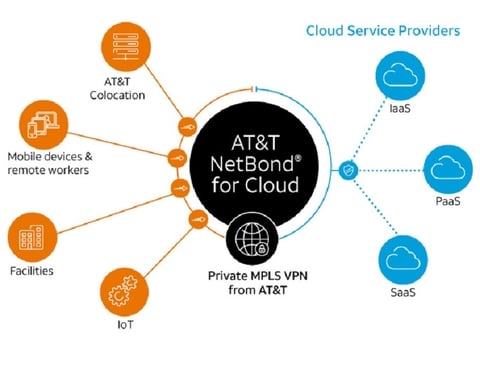AT&T business customers will soon be able to move workloads between any of their public, private and hybrid cloud platforms, leveraging the telco’s enhanced NetBond for Cloud service.
As businesses move more data, systems and applications to the cloud, they need their apps to interact across different clouds.
By implementing this new feature, a business can connect each ecosystem cloud—private or public—to another over a private AT&T network connection.
RELATED: AT&T adds Oracle’s FastConnect to NetBond cloud ecosystem, scales to 20 cloud provider partners
NetBond service allows businesses to carry their service on AT&T’s private network. This means that AT&T can provide a more predictable network experience that is free from the latency issues of the public internet. AT&T NetBond for Cloud enables businesses to connect, or "bond," their AT&T VPN to whatever cloud provider a customer chooses.

Being able to move and manage connections between clouds is important as most businesses use, on average, three or more clouds, all of which are often a mix of public, private or hybrid clouds.
Rosa Maria Boza, VP of enterprise networking at AT&T, told FierceTelecom the new feature ties in well with businesses using multiple clouds.
“With the increasing use of public, private, and hybrid cloud environments, we have noticed more and more of customers are using multiple clouds,” Boza said. “You could imagine how a customer would use a cloud for storage and a cloud for compute, and it’s not a big leap from there to imagine a customer might need to link those two clouds together.”
Driving efficiency
Using the digital AT&T cloud portal, customers can manage connections between clouds. Instead of having to spend time with multiple cloud providers to build connection points individually, businesses can now create or change connectivity configurations within minutes.
The AT&T NetBond for Cloud ecosystem is made up of more than 20 members delivering access to over 130 major cloud services.
Prior to this feature, if customers wanted to link two clouds together they would have to pull information from their storage cloud to their data center and send it to their compute cloud.
“Before this announcement, a customer would have to buy two NetBond connections to achieve that and bring the traffic back,” Boza said. “Now what we’re saying is you buy one NetBond connection and go cloud to cloud all within the bandwidth considerations of that first cloud connection.”
One use case for this is data loss prevention. In this instance, a business could have their backup data stored on Azure and pull it back to the compute resource without coming through the data center.
Closing a gap
Being a pay-as-you-go model, NetBond allows customers to raise bandwidth as needed in various time increments.
A business customer could effectively scale up to 5 Gbps if it was doing a major system backup in the cloud, for example, and only pay for the bandwidth they need.
While other providers could start offering a similar service feature, AT&T wants to use it as a near-term differentiator to attract more customers to NetBond.
“It’s something we’ve seen a need for and a gap we noticed,” Boza said. “We decided we could easily do this and it’s a usage-based service that allows customers to pay as they consume.”
Boza added that a number of its customers are having their cloud services work in tandem with one another.
“We think this is a feature that as many customers are using multiple clouds interactively, not independently, it makes a lot of sense,” Boza said.